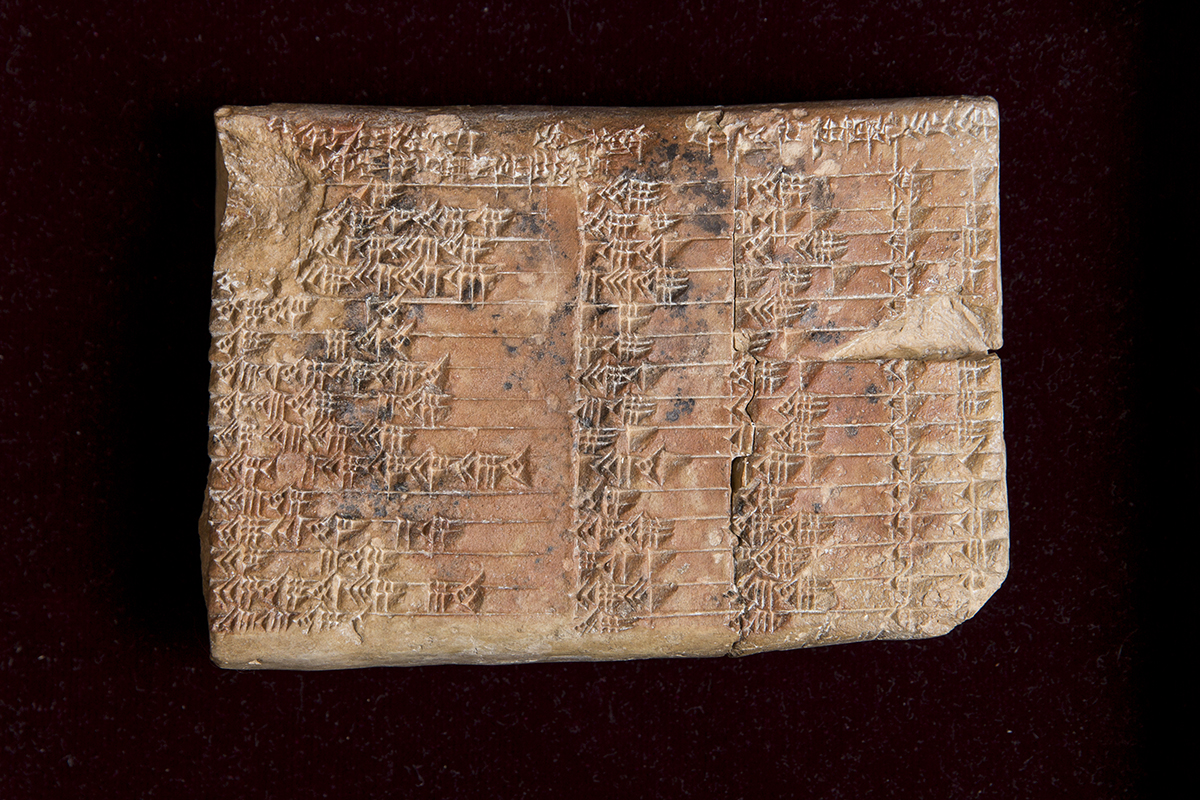Sine o' the Times: Babylonian Tablet Holds Oldest Evidence of Trigonometry

Scientists recently decoded a clay tablet from ancient Babylonia that dates to around 3,700 years ago, and found that it contains the oldest trigonometric table in the world.
The tablet, discovered in the early 1900s and first interpreted in 1945, has long fascinated mathematics scholars, but they were puzzled by its description of triangles, which researchers recently linked to a type of trigonometry.
These ancient mathematical inscriptions predate the earliest known evidence of trigonometry — thought to have originated around 120 B.C. with Greek astronomer Hipparchus — by approximately 1,000 years, the researchers reported in a new study.
This finding suggests that the Babylonians, not the ancient Greeks, were the first to study trigonometry — the mathematics of triangles — perhaps using it in architectural calculations for constructing pyramids, temples and palaces, the study authors wrote. [The 7 Most Mysterious Archaeological Finds on Earth]
The tablet, which measures 5 inches (12.7 centimeters) long and 3.5 inches (8.8 cm) wide, is known as Plimpton 322, named for its owner, American philanthropist George Arthur Plimpton, who purchased the artifact in 1922 from archaeologist and antiquities dealer Edgar Banks.
Banks — the real-life inspiration for the adventure-seeking archaeologist movie character Indiana Jones — discovered the clay object in Iraq. Similarities in its writing style to that on other Babylonian tablets enabled experts to date it to between 1822 B.C. and 1726 B.C., around the time that King Hammurabi ruled the Babylonian Empire.
Experts interpreted the 15 rows of characters written in four columns on the tablet as descriptions of 15 triangles forming right angles, with their angles of inclination decreasing incrementally, the study authors wrote.
Sign up for the Live Science daily newsletter now
Get the world’s most fascinating discoveries delivered straight to your inbox.
About 70 years ago, researchers determined that the notations on the tablet represented a special numerical pattern known as Pythagorean triples, a grouping of three positive integers, study co-author David Mansfield, a researcher with the School of Mathematics and Statistics at the University of New South Wales in Sydney, said in a statement.
"The huge mystery, until now, was its purpose — why the ancient scribes carried out the complex task of generating and sorting the numbers on the tablet," Mansfield said.
A new angle
Trigonometry analyzes the relationships between the sides and angles of triangles; it is intrinsic to geometry and plays an important role in other branches of mathematics. The study authors expanded on prior research suggesting that Plimpton 322 was broken and incomplete, and they determined that there were originally six columns of figures on the tablet. Relationships between numbers in the completed table would have represented a novel type of trigonometry — one that relied on ratios instead of angles and circles, according to the study.
"The tablet not only contains the world's oldest trigonometric table; it is also the only completely accurate trigonometric table, because of the very different Babylonian approach to arithmetic and geometry," Mansfield said.
The simplicity and accuracy of this once-lost form of Babylonian trigonometry "has clear advantages" over modern trigonometry, study co-author Norman Wildberger, an associate professor in the School of Mathematics and Statistics at the University of New South Wales in Sydney, said in the statement.
Archaeologists have uncovered numerous tablets produced during the time of the Babylonian Empire, but very few of them have been examined in detail. This study's findings hint that these understudied artifacts from a long-dead empire could hold exciting discoveries, not only for understanding the history of mathematics but also for enhancing how math is studied today, Wildberger explained.
"It opens up new possibilities not just for modern mathematics research, but also for mathematics education," he said. "The mathematical world is only waking up to the fact that this ancient but very sophisticated mathematical culture has much to teach us."
The findings were published online today (Aug. 24) in the journal Historia Mathematica.
Original article on Live Science.

Mindy Weisberger is an editor at Scholastic and a former Live Science channel editor and senior writer. She has reported on general science, covering climate change, paleontology, biology and space. Mindy studied film at Columbia University; prior to Live Science she produced, wrote and directed media for the American Museum of Natural History in New York City. Her videos about dinosaurs, astrophysics, biodiversity and evolution appear in museums and science centers worldwide, earning awards such as the CINE Golden Eagle and the Communicator Award of Excellence. Her writing has also appeared in Scientific American, The Washington Post and How It Works Magazine. Her book "Rise of the Zombie Bugs: The Surprising Science of Parasitic Mind Control" will be published in spring 2025 by Johns Hopkins University Press.









